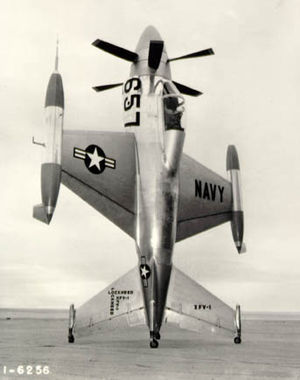Lockheed XFV-1
| Lockheed XFV-1 Salmon | |
|---|---|

|
|
| Type: | Prototype of a VTOL - combat aircraft |
| Design country: | |
| Manufacturer: | |
| First flight: |
December 23, 1953 |
| Commissioning: |
was never put into service |
| Production time: |
was never mass-produced |
| Number of pieces: |
2 (1 airworthy) |
The Lockheed XFV-1 Salmon is a single-seater rear starter developed in the USA in the 1950s for interception. The additional name Salmon was not officially given, but probably comes from the name of the test pilot Herman "Fish" Salmon. Most of the time, however, the machine was addressed as a pogo , although the name was officially given to the competing design of the Convair XFY-1 . Clarence Johnson was the development manager and Lockheed project number was 081-400.
The machine was based on a completely unconventional concept. The XFV-1 was an all-metal mid-wing aircraft with trapezoidal wings and a tail unit consisting of cross-shaped surfaces. When starting operation was scheduled the resting on a small chassis at the rear tail XFV-1 by two opposing, from a turboprop powered -Triebwerk propeller to lift vertically into the air. Subsequently, the transition to the horizontal flight condition was planned. The landing process should proceed in reverse order.
The development began in 1947, when the US Navy and Air Force, based on a scenario of airports destroyed by Soviet attacks, required a fighter aircraft with minimal space requirements for take-off and landing. Similar approaches were already at the end of World War II in Focke-Wulf and Heinkel . In addition to the Lockheed XFV-1, a development contract was also awarded for the Convair XFY-1.
For flight tests, the XFV-1 was provisionally equipped with a rigid, conventional tail wheel landing gear, as a vertical take-off was not possible due to the insufficient engine power. The machine took off on its maiden flight on December 23, 1953 . Transitions from the horizontal to the vertical flight condition and back were only carried out at a safe height without attempting a landing. These flight tests, which were carried out by the experienced test pilot Herman Salmon , showed that this process would be extremely risky for a normal pilot under difficult conditions.
A total of 32 flights were made before the project was discontinued in June 1955. In the USA there were then further developments of vertical take-off aircraft, all of which remained more or less unsuccessful. It was not until the Hawker Siddeley Harrier that the viability of a vertical take-off was demonstrated.
The only airworthy prototype has survived and is in the Florida Air Museum in Lakeland, Florida .
Technical specifications
| Parameter | Data |
|---|---|
| crew | 1 |
| length | 11.43 m |
| span | 8.35 m |
| height | ? m |
| Wing area | 22.85 m² |
| Propeller diameter | 4.88 m |
| Empty mass | 5,263 kg |
| Max. Takeoff mass | 7,360 kg |
| Top speed | 930 km / h at an altitude of 4,500 m |
| Service ceiling | 13,200 m |
| Range | 845 km |
| Engines | an Allison YT40 -A-6 turboprop with 5,850 shp (4,362 kW) |
| Armament (planned) | four 20 mm automatic cannons, 48 × 70 mm air-to-air missiles. Prototype unarmed |